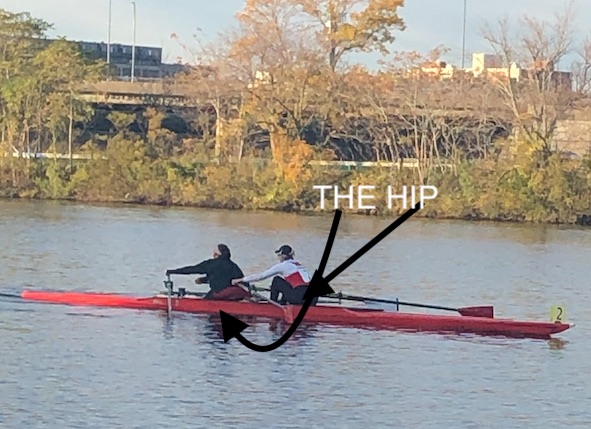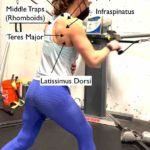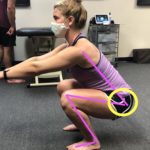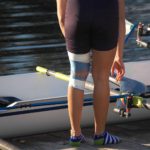The Hip:
The rowing stroke is very centered around the pelvis. Whether you are a para athlete, master rower or elite, how your hips relate to the boat in the seat matters! It’s your physical connection to the seat. Your hips move in grossly two planes for rowing: frontal (flexion and extension) and transverse (rotation). If you use upright activities like running or skiing as cross training a third plane, sagittal (moving sideways) comes into play. That said, all of these directions matter when you are carrying your boat to the dock, taking it in and out of a rack or loading a trailer. Your hips/pelvis are always a piece to the puzzle!
The key muscle groups are:
- Hip Flexors: ilopsoas and some help from quads
- Hip Extensors: gluteus maximus, upper fibers of hamstring group
- Adductor magnus and glut medius play a role!
- Hip Internal Rotators:
- Hip External Rotators: piriformis, quadratus femoris, obturator internus and externus, gemellus superior and inferior
- Gluts, psoas and sartorius also play a role!
Pictured below because there’s more than you thought! (Keeping these strong and mobile is huge for mobility, control and painfree rowing)
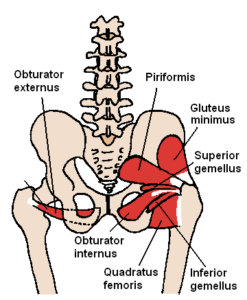
The Hip and Your Rowing Stroke:
Having hip, groin, knee and even low back pain can all be related to mobility and strength of your hips. There is a high demand for a huge range of motion, strength and stability throughout the rowing stroke that comes from and links through your hips. Think about it, your hips/pelvis are the hinge point for connecting the effort of your legs to your torso and arms to get the most power and speed out of your stroke. Rowing is a unique sport in that you are seated and working in a non-impact, gravity reduced, fairly symmetrical pattern. That said, each stroke asks for your body to work as a whole system. You need power to transfer from the footboards through your hips, back and shoulders to your arms and the handle. Being strong enough to make this happen, having good mobility, and having a good movement pattern of hinging and opening are important.
We have all seen people who through the recovery, for extra length or for lack of control, spread their knees wide and continue up to the catch, lunging through their legs for that extra tiny bit of length or just to match their boat. Now when they go to change directions, it is not a nice quick translation from blade placement to press into the drive, their hips first have to find neutral, which often happens while their legs drive is occurring, loosing that initial press power and changing their power curve. This can also lead to putting the load too fast up the chain and causing other problems.
Hip strength and mobility will also be in your favor for getting boats in and out of racks, reaching boats up and overhead and placing them in and taking them out of the water. If you have experienced tighter hamstrings or a stiff low back you have felt the need to avoid using a hinge or avoiding using your hips to help with these movements. Whether you stoop with a hand on your knees while waiting for your boat mates to start picking up the boat or if you have to use excessive knee bending to get to the boat, all of this can be partially improved with stronger hips and a better hinge pattern. Now for our masters out there, there might just be some other strategies you need to mix with more strength for that in and out of the water piece. A new post on mechanics with hip and knee replacements is coming soon!
How do I make my hips stronger?
There are two components to think about when it comes to hip strength and a few other key things to think about in terms of flexibility and range. First strength. You need hip extension strength through the back of your hips and hip rotation control through the outsides of your hips. These are both very tricky and often lacking in most rowers. The tricky part is, a lot of rowers find it difficult to access their gluts as hip extensors to help open their body during the drive. This is something to play with, seeing if you can feel your gluts contracting as you open your body (A great thing to play with on the erg!). Hip rotation control mostly comes from the outside of your hips, using your hip rotators to maintain neutral rotation of your hip as you cycle through a rowing stroke.
Here are some effective, easy, do anywhere, with or without equipment exercises to work on both aspects of your hip strength!
The bonus for getting your hips stronger is that most cross-training options (running, cross country skiing, biking, swimming…) all benefit from stronger hips to prevent injury!
3 sets of 10-15 are generally what you want for most stability strength work. (Depending on how much resistance and how hard it is for you)

